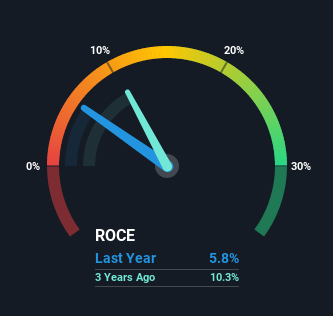Bhartiya International's (NSE:BIL) Returns On Capital Not Reflecting Well On The Business

Finding a business that has the potential to grow substantially is not easy, but it is possible if we look at a few key financial metrics. Ideally, a business will show two trends; firstly a growing return on capital employed (ROCE) and secondly, an increasing amount of capital employed. If you see this, it typically means it's a company with a great business model and plenty of profitable reinvestment opportunities. However, after investigating Bhartiya International (NSE:BIL), we don't think it's current trends fit the mold of a multi-bagger.
What is Return On Capital Employed (ROCE)?
If you haven't worked with ROCE before, it measures the 'return' (pre-tax profit) a company generates from capital employed in its business. The formula for this calculation on Bhartiya International is:
Return on Capital Employed = Earnings Before Interest and Tax (EBIT) ÷ (Total Assets - Current Liabilities)
0.058 = ₹265m ÷ (₹9.5b - ₹5.0b) (Based on the trailing twelve months to December 2020).
Therefore, Bhartiya International has an ROCE of 5.8%. Ultimately, that's a low return and it under-performs the Luxury industry average of 9.6%.
Check out our latest analysis for Bhartiya International

While the past is not representative of the future, it can be helpful to know how a company has performed historically, which is why we have this chart above. If you want to delve into the historical earnings, revenue and cash flow of Bhartiya International, check out these free graphs here.
What Does the ROCE Trend For Bhartiya International Tell Us?
In terms of Bhartiya International's historical ROCE movements, the trend isn't fantastic. Around five years ago the returns on capital were 20%, but since then they've fallen to 5.8%. And considering revenue has dropped while employing more capital, we'd be cautious. This could mean that the business is losing its competitive advantage or market share, because while more money is being put into ventures, it's actually producing a lower return - "less bang for their buck" per se.
On a separate but related note, it's important to know that Bhartiya International has a current liabilities to total assets ratio of 52%, which we'd consider pretty high. This can bring about some risks because the company is basically operating with a rather large reliance on its suppliers or other sorts of short-term creditors. Ideally we'd like to see this reduce as that would mean fewer obligations bearing risks.
Our Take On Bhartiya International's ROCE
From the above analysis, we find it rather worrisome that returns on capital and sales for Bhartiya International have fallen, meanwhile the business is employing more capital than it was five years ago. It should come as no surprise then that the stock has fallen 55% over the last five years, so it looks like investors are recognizing these changes. With underlying trends that aren't great in these areas, we'd consider looking elsewhere.
Bhartiya International does have some risks, we noticed 4 warning signs (and 2 which shouldn't be ignored) we think you should know about.
For those who like to invest in solid companies, check out this free list of companies with solid balance sheets and high returns on equity.
If you’re looking to trade Bhartiya International, open an account with the lowest-cost* platform trusted by professionals, Interactive Brokers. Their clients from over 200 countries and territories trade stocks, options, futures, forex, bonds and funds worldwide from a single integrated account. Promoted
Valuation is complex, but we're here to simplify it.
Discover if Bhartiya International might be undervalued or overvalued with our detailed analysis, featuring fair value estimates, potential risks, dividends, insider trades, and its financial condition.
Access Free AnalysisThis article by Simply Wall St is general in nature. It does not constitute a recommendation to buy or sell any stock, and does not take account of your objectives, or your financial situation. We aim to bring you long-term focused analysis driven by fundamental data. Note that our analysis may not factor in the latest price-sensitive company announcements or qualitative material. Simply Wall St has no position in any stocks mentioned.
*Interactive Brokers Rated Lowest Cost Broker by StockBrokers.com Annual Online Review 2020
Have feedback on this article? Concerned about the content? Get in touch with us directly. Alternatively, email editorial-team (at) simplywallst.com.
About NSEI:BIL
Bhartiya International
Manufactures, trades in, and sells leather and textile products in India.
Questionable track record with imperfect balance sheet.
Similar Companies
Market Insights
Community Narratives



